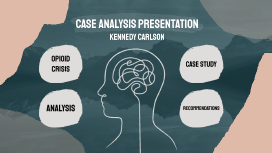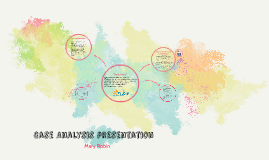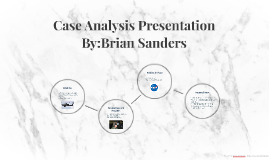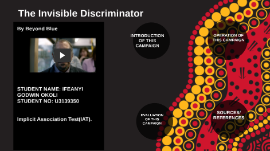CASE ANALYSIS PRESENTATION
Transcript: By Beyond Blue STUDENT NAME: IFEANYI GODWIN OKOLI STUDENT NO: U3139350 Implicit Association Test(IAT). Ha The Invisible Discriminator INTRODUCTION OF THIS CAMPAIGN Acknowledgment of Country I would like to acknowledge the Ngunnawal and Ngambri people who are the traditional custodians of this land on which we are meeting and pay respect to the Elders of Ngunnawal and Ngambri Nations both past and present. I extend this respect to all aboriginal and Torres Strait Islander peoples in attendance today. The Reason I choose this campaign WHY? History of Australia(story). First People of the land. Stereotypes about Aboriginal and Torres Strait Island People. Indigenous Rights. Education and Health Related Issues. Main Objectives Beyond Blue (Founded October 2000) Beyond Blue is an Australian independent non-profit organisation working to address issues associated with depression, suicide, anxiety, disorders and other mental related disorders From July 2014 beyond blue created this national social marketing campaign which highlights the impact of racial discrimination on the social and well being of aboriginal and Torres strait Islander people. Also commissioned TNS Social Research to evaluate the reach and the impact of the campaign on the target audience, which is non-Indigenous people aged 25-44 years. Beyond Blue Campaign Objectives Message of this Campaign. Stop, Think and Respect! ( Non-indigenous people of Australia) "Social Marketing is the application of commercial marketing concepts and tools to influence the voluntary behavior of target audiences to improve their lives or the society of which they are a part."_Andreasen,2014. What are the target group? OPERATION OF THIS CAMPAIGN This campaign aims to Eliminate the impact of discrimination,racist attitudes and stereotypical beliefs has on Indigenous Australians by tapping into perceptions and bias of Non-Indigenous people. "The campaign purpose, by contrast, is the ultimate impact(benefit) that will be realized if your target audience performs the desired behaviors at the intended levels."_Lee & kotler,2015. What made the campaign so successful and effective? Success/Effectiveness (Strategic communication can be defined as “the purposeful use of communication by an organization to fulfill its mission” _Hallahan et al., 2007, p. 3). Positioning Statement used? Behavior-Focused Positioning Focus -To (modify,Reject and Abandon) discriminatory attitudes based on (non-indigenous people) perception and bias. What Persuasion Strategies/Tactics were used? Persuasion Strategies influence behavior desired behavior Target Audience "Independent research has found that Aboriginal and Torres Strait Islander people and people with an African background frequently experience racism at work or while using public services such as transport." _ Australian Human Rights Commission,2014 What could be done better? EVALUATION OF THIS CAMPAIGN what do you think about the IAT? How was the presentation? How do you feel about the campaign video(message)? Questions/Feedback? Andreasen, A. R., & Kotler, P. (2014). Strategic marketing for nonprofit organizations. Strategic Marketing for Nonprofit Organizations. Harlow, Pearson Education Limited. NancyR.Lee, Philip kotler, Soicial marketing: Changing Behaviors for Good; Sage Publication,2015 ed 5. Kirk Hallahan, Derina Holtzhausen, Betteke van Ruler, Dejan Verčič & Krishnamurthy Sriramesh (2007) Defining Strategic Communication, International Journal of Strategic Communication, 1:1, 3-35, DOI: 10.1080/15531180701285244 Mathew Trinca, 'Museums and the History Wars' (Links to an external site.), History Australia, Vol. 1, No. 1, 2003, pp. 85-97. Guy Hansen, ‘Telling the Australian story at the National Museum of Australia: “Once upon a time...”’ (Links to an external site.), History Australia, Vol. 2, No. 3, 2005, pp. 91–99. Nathan Sentance, “My Ancestors Are in Our Memory Institutions, but Their Voices Are Missing” (Links to an external site.), The Guardian, March 6, 2018. National Museum of Australia, Encounters: Reflections on history, culture and museums (Links to an external site.), YouTube, 2017 Adam Goodes-Australian of the Year 2014 Acceptance Speech,Australian of the Year Awards. Elevator- racism,Racism it stops with me, https://www.youtube.com/watch?v=nx32huxgaKg. Australian Human Rights Commision, October,2014.https://itstopswithme.humanrights.gov.au/ Indigenous Art Edition PPE Shirts-Maliyan Horizon, www.facebook.com/indyamarramaliyan Arts. Beyondblue:Depression and Anxiety, www.beyondblue.org.au/getsupport. Implicit Association Test: Project implicit, Harvard University.implicit.harvard.edu. Paradies, Y., Harris, R. and Anderson, I. 2008, The Impact of Racism on Indigenous Health in Australia and Aotearoa: Towards a Research Agenda, Discussion Paper No. 4, Cooperative Research Centre for Aboriginal Health, Darwin. <www.crcah.org.au> References: SOURCES/REFERENCES

















